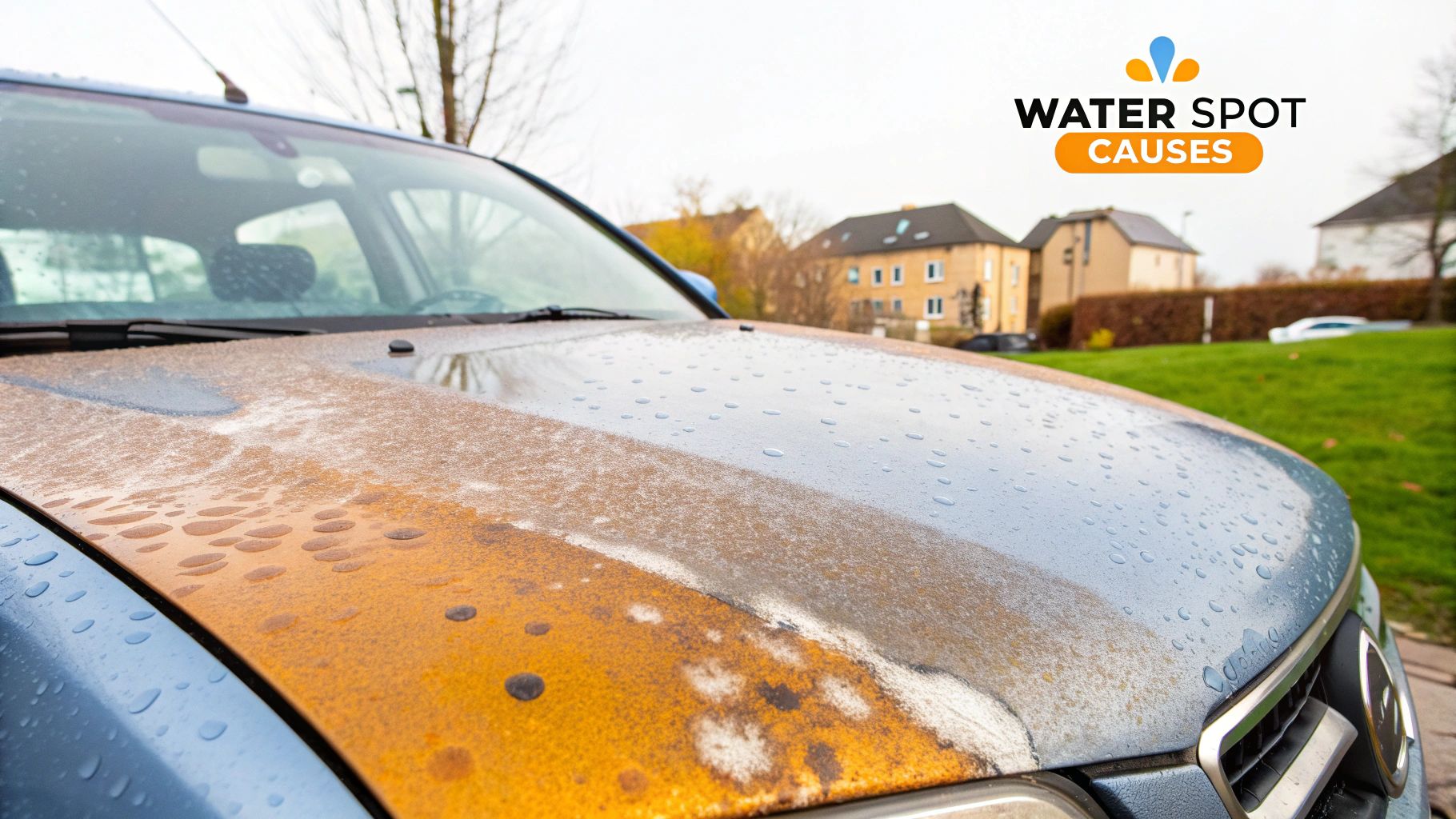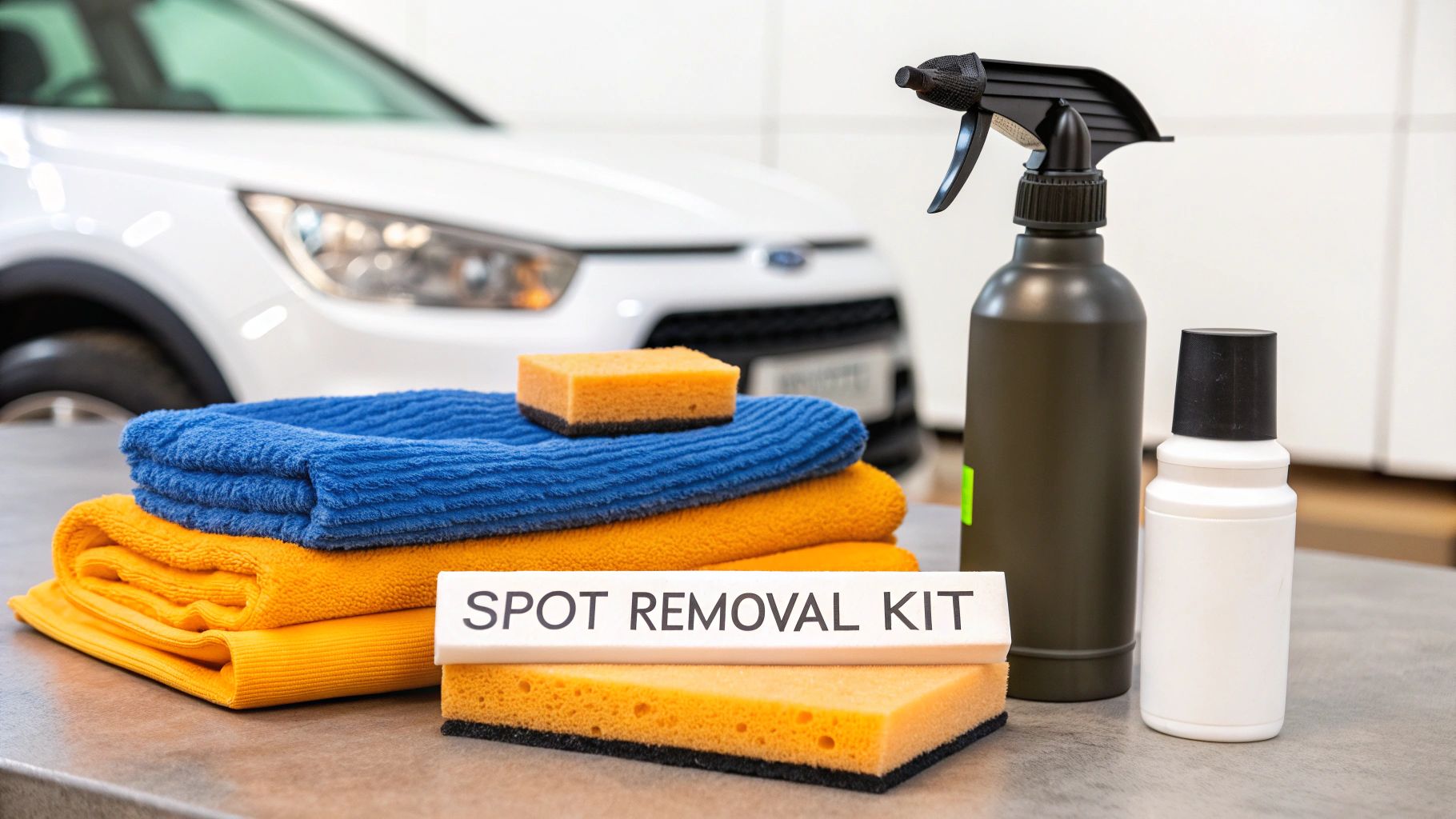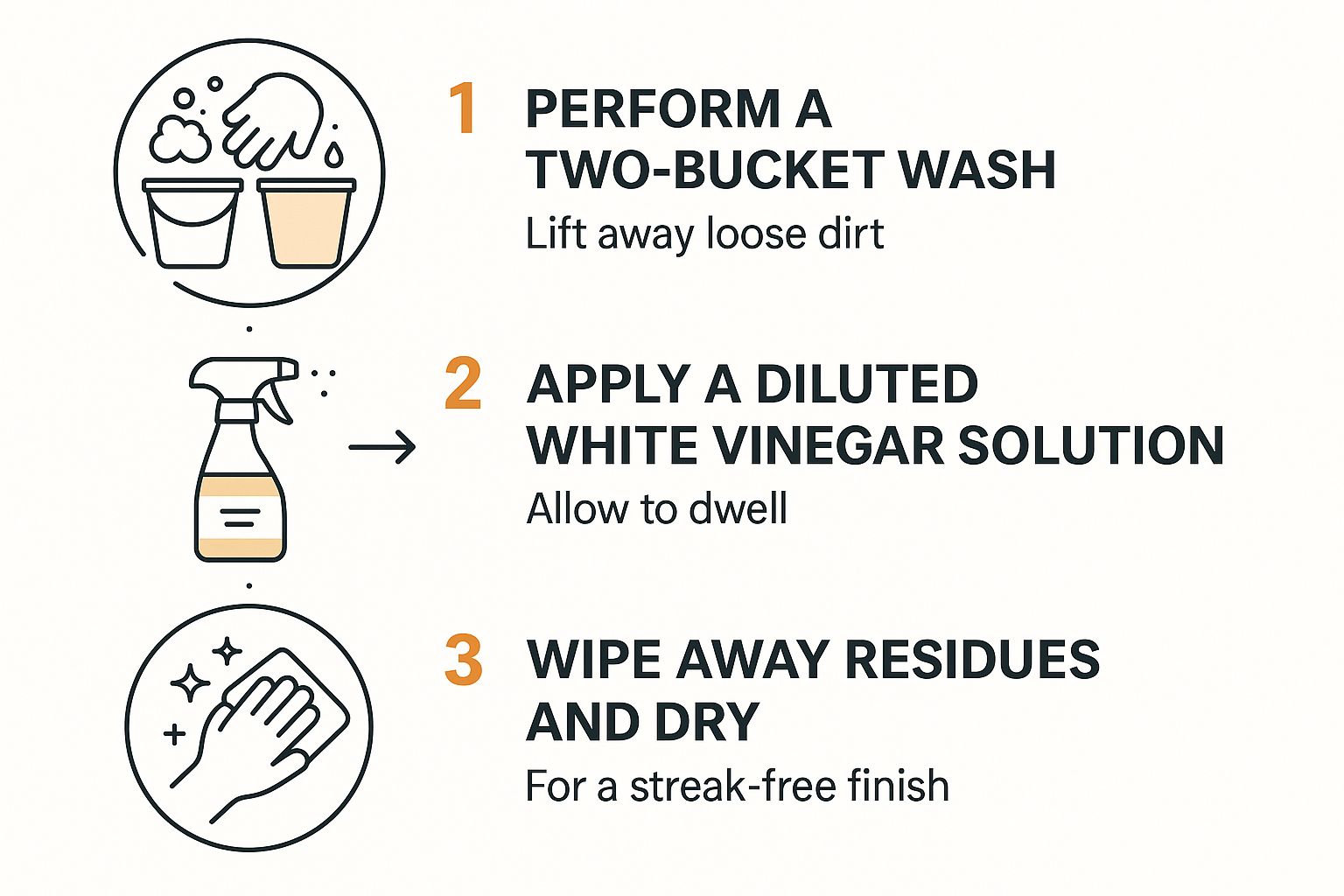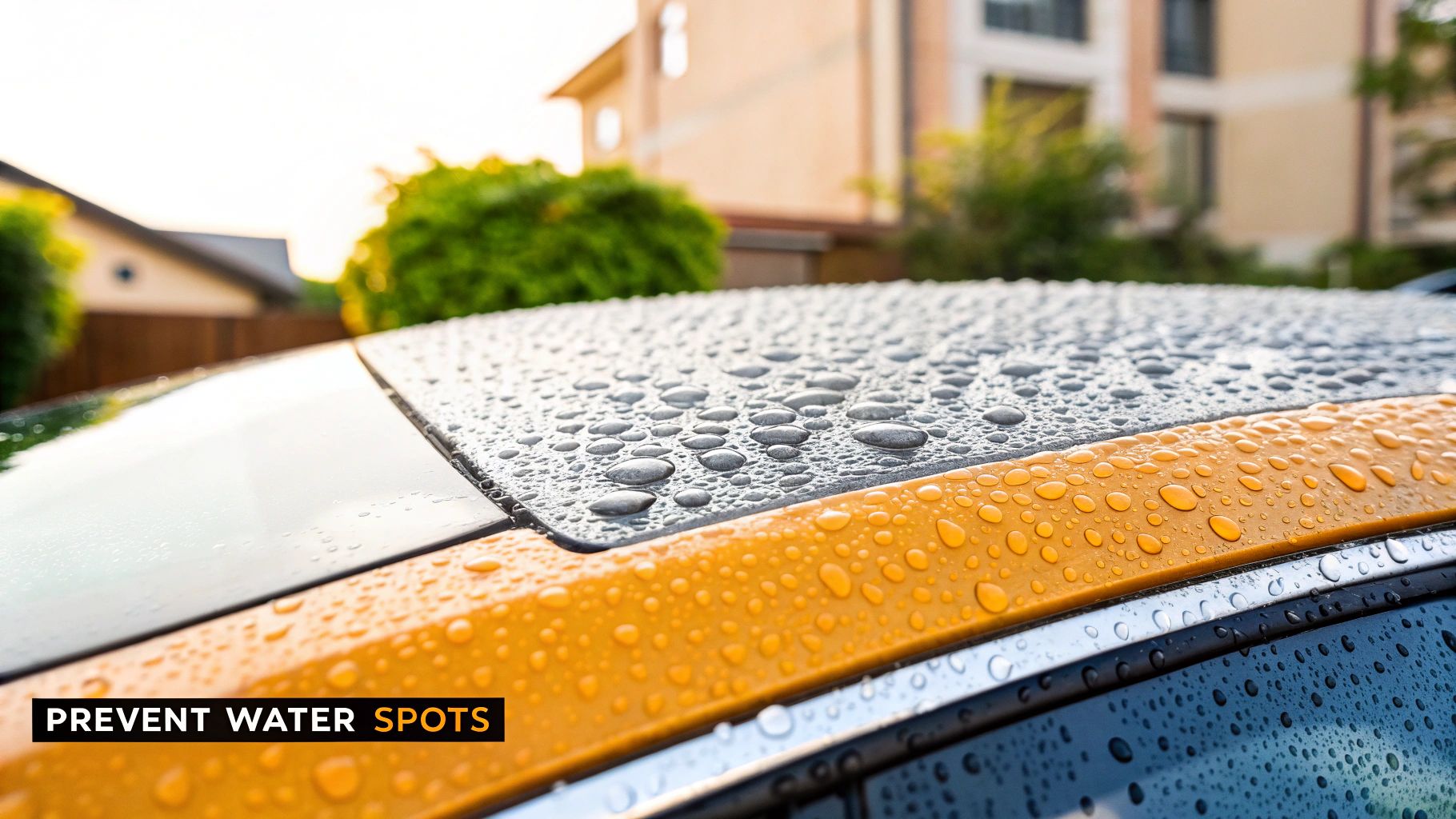If you've ever meticulously washed your car on a beautiful day, only to come back and find it speckled with frustrating little circles, you know the pain of water spots. These aren't just dried water marks; they're the mineral ghosts left behind after every single droplet has evaporated.
The science is pretty straightforward. Water is a great solvent, and it's full of dissolved minerals. When a bead of water sits on your paint and dries up, the water goes, but the minerals—calcium, magnesium, and other grime—stay put. That residue is what you see as a spot.
What Causes Those Annoying Water Spots

The real trick to getting rid of these spots for good is figuring out what kind of water caused them in the first place. Believe it or not, not all water is the same, and the source is everything when it comes to a spotless finish.
Identifying The Three Types Of Water Spots
Before you grab any random bottle off the shelf, you need to play detective. Diagnosing the type of spot on your car is the only way to choose the right game plan. This quick table breaks down what you're likely looking at.
| Spot Type | Appearance | Common Cause | Removal Method |
|---|---|---|---|
| Type 1: Mineral Deposits | Light, chalky, white circles that sit on top of the paint. | Tap water from a hose or sprinklers (hard water). | Simple wash, quick detailer, or vinegar solution. |
| Type 2: Bonded Minerals | Harsher, more defined spots that feel slightly raised. | Rain mixed with pollutants, which then bakes onto the surface. | Clay bar or a dedicated water spot remover. |
| Type 3: Etching | Sunken-in, crater-like marks that are below the surface. | Acid rain or hard water spots left to sit for a long time in the sun. | Polishing, compounding, or even wet sanding. |
Ultimately, you need to determine if you're dealing with a deposit on the paint or damage to the paint. The first is a cleaning job; the second is a correction job.
Why Your Location and Water Source Matter
Where you live plays a huge role in the battle against water spots. If you're in a region known for "hard water"—and that includes large parts of the United States—your tap water is loaded with minerals just waiting to ruin your day. These are your classic Type 1 spots. For a much deeper look into tackling this specific problem, check out our complete guide: https://www.swiftjetusa.com/blogs/news/hard-water-car-wash-mastery-tried-and-true-expert-solutions
Rain can be just as bad, if not worse. As raindrops fall, they pick up airborne pollutants and can become slightly acidic. When that contaminated water dries, you get stubborn Type 2 bonded mineral spots.
Let either of those sit and bake in the sun for too long, and you get the worst-case scenario: Type 3 etching. The minerals and acids literally eat into your car's clear coat, creating tiny pits that can't just be wiped away. This is physical damage.
The problem often comes down to mineral content and pH. For a closer look at the science behind this, you can learn more by understanding water's alkaline properties. Knowing what you're up against locally helps you prevent these frustrating blemishes before they have a chance to become a permanent headache.
Building Your Water Spot Removal Toolkit

Trying to remove water spots without the right gear is like attempting to paint a masterpiece with a toothbrush. You just won't get the results you're after. Building a dedicated arsenal is key, but don't worry—you don't need to buy every single product on the shelf. Let’s focus on the essentials that actually work.
First things first, get rid of the dish soap. Your number one investment should be a quality, pH-neutral car shampoo. These soaps are specifically formulated to clean your paint without stripping off the wax or sealant you've already applied. They protect your car's finish while lifting away grime.
Just as important as the soap is what you use to apply and dry it. Always, and I mean always, use high-quality microfiber towels. Their soft, dense fibers are designed to trap dirt particles, not just push them around, which is how you get those dreaded swirl marks. A separate, ultra-plush drying towel will also be your best friend in preventing spots from forming in the first place.
Tools for Different Spot Severities
So, what do you grab when you see those annoying little circles? It depends on how bad they are.
For those fresh, light spots that just appeared after a quick rain shower or a wash, your toolkit can stay simple. A good quick detailer spray is often all you need. It lubricates the surface, allowing you to safely wipe away the light mineral deposits without scratching the paint.
When you're dealing with more stubborn, bonded minerals—what we call Type 2 spots—it's time to bring out the bigger guns. This is where a dedicated water spot remover earns its keep. Most of these are mild acidic formulas designed to chemically dissolve the calcium and magnesium that a normal wash won't touch.
A lot of people suggest using a vinegar solution, and while a 50/50 mix of distilled white vinegar and water can work on very light spots, it's not a silver bullet. It lacks the specialized lubricants and agents that a professional product has, which are designed to be safe on modern automotive clear coats.
Advanced Contamination Removal
If you wash the car and the surface still feels rough or gritty to the touch, you've got bonded contaminants. This is clay bar territory. When used with a proper clay lubricant, the bar glides across the paint and shears off anything stuck to the surface, from mineral deposits to industrial fallout, leaving it perfectly smooth.
Finally, for the worst-case scenario—etched spots (Type 3) that have physically damaged the clear coat—you'll need to step up to a light polishing compound and an applicator pad. Polishing is a gentle abrasive process that levels the clear coat around the etch, effectively erasing it.
Having the right tool for the job makes all the difference. To see what a complete setup looks like, check out our comprehensive car detailing supplies list and make sure you're ready for anything.
Tackling Fresh and Light Water Spots
If you catch water spots early—before the sun has had a chance to really bake them into the paint—getting rid of them is usually pretty simple. This is your first line of defense, a quick and easy routine that keeps your car looking sharp without having to break out the heavy-duty products. The trick is to act fast with the right, gentle approach.
Before you attack the spots themselves, you need a clean surface. Always, and I mean always, start with a proper wash. I can't stress the two-bucket wash method enough here. One bucket for your soapy water, one for rinsing your wash mitt. This tiny step is what separates a clean car from a scratched one, as it stops you from dragging grit all over your paint.
The Vinegar Solution: A Gentle First Step
For those light, brand-new spots, a simple household staple works wonders. Mix up a solution of 50% distilled white vinegar and 50% distilled water in a spray bottle. The mild acidity of the vinegar is perfect for dissolving the alkaline minerals that cause the spots.
And yes, you must use distilled water. Using tap water just puts more minerals right back onto the car, and you'll be chasing your tail.
My Two Cents: Never, ever do this in direct sunlight or when the car's body panels are hot. Heat makes the solution evaporate way too fast, which can leave behind a concentrated acidic residue that’s worse than the original spot. Always find some shade and work on a cool surface.
Once you've mixed your solution, lightly spray it onto a small section. Let it sit for about 30 to 60 seconds, but that's it. This gives the vinegar just enough time to do its job without risking any damage to your clear coat. Take a plush, clean microfiber towel and gently wipe the area without applying any real pressure. Then, just flip the towel to a dry side and give it a final buff.
This visual guide gives you a great overview of the process.

As you can see, it’s a straightforward cycle of cleaning, treating, and drying that gets you back to a perfect, spot-free shine.
When to Reach for a Quick Detailer
If making your own concoction isn't your thing, a good quick detailer spray is the perfect alternative. In many cases, it's the safer option. These sprays are engineered with special lubricants that get underneath the mineral deposits and dust, lifting them off the paint so you can wipe them away without causing scratches.
The process is a lot like using the vinegar mix but a bit more forgiving.
- Spray it on: Give the panel a liberal misting of the quick detailer. Don't be shy.
- Wipe away: With a clean microfiber, gently wipe in one direction to lift the spots and the spray.
- Buff it out: Flip to a dry part of your towel and give the area a light buff to clear up any streaks.
This is my go-to method for dealing with the aftermath of a surprise rain shower or for that final pass after a car wash. Knowing how to remove water spots from car paint while they're still fresh saves you a massive headache later on. It’s the easiest way to stop a minor annoyance from becoming a serious, paint-damaging problem.
Advanced Tactics for Stubborn and Etched Spots
So, you've tried the quick detailer and even the vinegar trick, but those stubborn water spots are just laughing at you. When a simple wipe-down doesn't make a dent, you're no longer dealing with fresh surface deposits.
This is where you get into the more serious stuff: Type 2 spots, where minerals have bonded to the paint, or worse, Type 3 spots, where the etching process has already begun to eat into your car’s clear coat. Don't worry, it's not time to panic. It just means we need to bring out the bigger guns.
We're shifting from gentle chemical cleaners to more direct, and sometimes mechanical, methods. The goal is always to remove the problem without creating a bigger one, like accidentally scratching or swirling the paint.
Using a Clay Bar for That Gritty Feeling
Go ahead and run your clean hand over the paint. If it feels gritty or rough even after a good wash, you're feeling bonded contaminants. These are the mineral deposits, road grime, and industrial fallout that have essentially glued themselves onto your clear coat. A regular wash just slides right over them. A clay bar, however, is designed specifically to grab them.
Think of it like an exfoliating treatment for your car. The clay, combined with a slick lubricant, glides across the paint and literally shears off these tiny bumps, pulling them safely into the clay patty.
- Lube is Your Best Friend: Never, ever use a clay bar on a dry surface. You'll just drag grit across the paint and cause scratches. A dedicated clay lube or even a good quality quick detailer is non-negotiable.
- Work Small: Tackle one manageable section at a time, maybe a 2x2 foot square. Knead the clay into a flat patty and just glide it back and forth over the lubricated area with light pressure.
- Feel the Difference: You'll actually feel the surface go from rough to perfectly smooth under your hand. Once it feels like glass, you’re done with that spot. Remember to fold the clay to a fresh, clean side often so you aren't just rubbing the gunk you just picked up back into the paint.
This process physically lifts away the minerals causing those stubborn spots, leaving behind an incredibly smooth and decontaminated surface. For a complete tutorial, check out our guide on how to clay bar a car.
Dissolving Heavy Minerals with a Dedicated Remover
Sometimes, the mineral buildup is just too caked-on for a clay bar alone. That's when you turn to a dedicated water spot remover. These are typically mild, acid-based formulas designed specifically to dissolve the heavy calcium and magnesium deposits without being harsh on your paint.
My Pro Tip: Always work in the shade on a cool panel. Heat can cause these products to evaporate too quickly and potentially stain the paint. Apply the remover, let it sit for the recommended time—usually 30-60 seconds—and then gently wipe it away with a clean microfiber towel. Don't let it dry on the surface!
When All Else Fails: Polishing Out the Etching
If you've clayed the surface and hit it with a chemical remover but can still see the faint ghost of a water spot, you're dealing with etching. The minerals have sat for so long that they've eaten a microscopic crater into the clear coat.
At this point, no amount of cleaning will fix it. The only solution is to level the surrounding clear coat down to the bottom of the etch. This is what polishing does.
You can attempt this by hand with a good polishing compound and a microfiber applicator pad, but be prepared for a serious workout. For a much more effective and consistent result, a dual-action (DA) machine polisher is the right tool for the job.
Using a combination of a light-cut polish and a polishing pad, the DA polisher gently abrades an incredibly thin layer of the clear coat, effectively erasing the etch marks and restoring a flawless, reflective finish. This is the final frontier for water spot removal and the only true way to fix paint that has been physically damaged.
Keeping Water Spots from Coming Back for Good

You just spent all that time and energy getting rid of those frustrating water spots. The last thing you want is to see them pop right back up after the next wash or rain shower. Honestly, the best detailing is the work you don't have to do in the first place.
Shifting from a reactive "removal" mindset to a proactive "prevention" one will save you a ton of frustration and keep your paint looking flawless.
The absolute number one rule? Never, ever let your car air dry. Every single drop of water left on the paint is a tiny ticking time bomb, just waiting to evaporate and leave its mineral payload behind.
This is non-negotiable. Grab a high-quality, plush microfiber drying towel—the kind that can soak up a serious amount of water without just pushing it around. If you want to take it a step further, a leaf blower or a dedicated car dryer is a fantastic touchless option. They blast water out of every nook and cranny, eliminating those sneaky drips from mirrors and trim that always ruin a perfect finish.
Lay Down a Protective Barrier
Beyond just drying, the best long-term strategy is to make your paint so slick that water just can't stick. You want to apply a layer of protection that forces water to bead up and roll away, a quality we call being hydrophobic.
You've got a few great options here, each with its own pros and cons in terms of durability, looks, and effort.
- Traditional Carnauba Wax: This is the old-school favorite for a reason. Carnauba gives your paint a deep, warm glow and decent water beading. It's easy to apply, but you'll likely be re-applying it every couple of months.
- Paint Sealant: Think of a sealant as a synthetic, supercharged wax. These polymer-based products create a slick, durable shield that easily outlasts carnauba, often lasting up to six months. They give you fantastic protection and a sharp, glassy shine.
- Ceramic Coating: This is the top dog of paint protection. A ceramic coating creates a semi-permanent, super-hard layer on your clear coat that's incredibly slick and resistant to chemicals. Water practically jumps off the surface, and it’s much harder for mineral deposits to bond or etch into the paint. One professional application can last for years.
A good layer of protection basically gives your car a non-stick frying pan finish. Water can’t spread out and dry flat; instead, it forms tight little beads that just roll away with a bit of wind or a quick blast from a blower.
Park Smart and Be Aware of Your Surroundings
Finally, a little bit of common sense can save you a world of headaches. Pay attention to where you park your car.
The biggest culprits? Sprinklers. Never park next to them. They're notorious for dousing cars with hard, mineral-heavy water that bakes on in the sun.
Also, look up. Avoid parking under awnings or near air conditioning units that might drip condensation onto your car. If you're in a hot climate, knowing how to prepare your car for extreme heat can make a huge difference, as the sun will accelerate how quickly spots form and etch. By combining great protection with smart habits, you can stop water spots before they even get a chance to start.
Answering Your Top Questions About Water Spot Removal
Even with a solid plan, a few questions always seem to pop up when you're dealing with stubborn water spots. I hear them all the time from fellow car enthusiasts. Let's tackle some of the most common concerns and myths so you can work on your car's paint with total confidence.
One of the biggest questions I get is about using plain old white vinegar. People hear it's a cheap, easy fix. And yes, a 50/50 mix of vinegar and distilled water can work on very fresh, light mineral deposits. But it’s definitely not a cure-all.
Professional water spot removers are engineered for this exact job. They contain special lubricants and other ingredients that protect your car's clear coat. Vinegar doesn't have any of that, which means you're running a higher risk of causing micro-scratches as you wipe the minerals away.
When Is a Water Spot Permanent?
This is the one that keeps car owners up at night: "Is this spot here to stay?" You'll know a spot has become permanent "etching" when you can't get it out with a chemical remover or even a clay bar.
If you’ve gone through all the decontamination steps and you can still see the distinct ring or outline of the spot, you’re no longer dealing with a surface-level deposit. The minerals have physically eaten into the clear coat itself.
At this stage, the damage is below the surface. No amount of cleaning will lift it away. The only fix is to carefully level the clear coat around it using a machine polisher and compound. If you're not experienced with paint correction, this is definitely the time to call in a professional detailer.
It’s a common job for them. In fact, North America accounts for 37.36% of the global car detailing services market, where jobs like this are a daily occurrence. You can dig into more of the data on this booming industry through various market intelligence reports.
Do Ceramic Coatings Make My Car Indestructible?
I hear this misconception all the time. Let’s be clear: a high-quality ceramic coating is the single best defense you can have against water spots, but it does not make your car bulletproof.
A good coating is incredibly hydrophobic. This means water beads up and flies off the surface, which drastically reduces the chances for spots to form in the first place.
But here’s the reality: if you let hard water dry on a ceramic-coated car, especially out in the hot sun, it can and will leave mineral deposits. The huge advantage is that those minerals are now sitting on top of the tough, sacrificial coating instead of your delicate paint, making them infinitely easier and safer to remove.
Think of a ceramic coating as a high-tech shield, not an invisible force field. It gives you a massive leg up, but you still need to follow good washing and drying habits.
Ready to stop water spots before they have a chance to form? The SwiftJet Car Wash Foam Gun covers your car in a thick blanket of lubricating foam. It lifts dirt away safely and makes washing way faster and more effective. Grab yours today and see what a real pro-level wash feels like.
